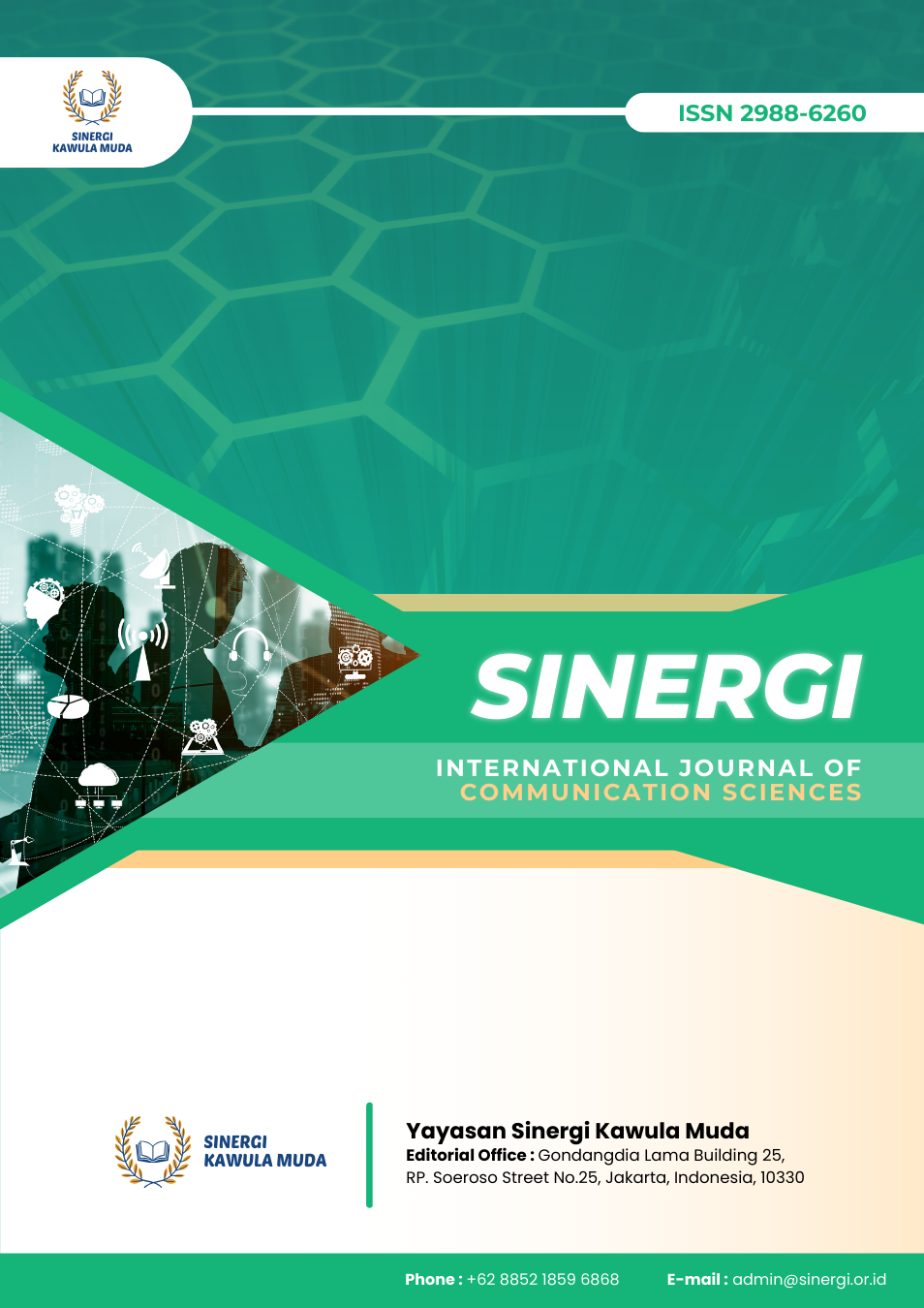Breaking Barriers: Organizational Adaptation for Effective Communication in Remote Work
DOI:
https://doi.org/10.61194/ijcs.v3i1.687Keywords:
Virtual Teams, Digital Communication, Organizational Structure, Hybrid Work, Collaborative Technology, Interpersonal Communication, Communication PolicyAbstract
In the digital era, virtual teams have become the norm in global work environments. However, communication within these teams is often hindered by rigid organizational structures inherited from traditional office settings, especially in healthcare settings where the stakes of miscommunication are significantly higher. This narrative review explores how structural barriers and inadequate adaptation to digital communication platforms compromise interpersonal interaction and team performance. The study employs a comprehensive literature review approach, synthesizing evidence from empirical studies and theoretical models to analyze the challenges and propose strategic interventions. The results indicate that inflexible hierarchies, lack of informal communication spaces, and poor integration of collaborative technologies significantly disrupt information flow and trust-building in virtual teams. Additionally, undefined roles and insufficient digital infrastructure contribute to confusion and miscommunication. The discussion emphasizes the urgency of adopting flexible structures and policies that support real-time, inclusive, and culturally sensitive communication. The review concludes that organizations must implement adaptive work frameworks, invest in digital training, and promote leadership models that align with virtual team dynamics. Recommendations include integrating AI-enabled feedback systems, developing operational guidelines for communication platforms, and designing cross-cultural training programs. These strategies are critical to overcoming structural communication barriers and enhancing team synergy in remote and hybrid environments.
References
Adamovic, M. (2017). An employee-focused human resource management perspective for the management of global virtual teams. The International Journal of Human Resource Management, 29(14), 2159-2187. https://doi.org/10.1080/09585192.2017.1323227 DOI: https://doi.org/10.1080/09585192.2017.1323227
Akdere, M., Jiang, Y., & Acheson, K. (2021). To simulate or not to simulate? comparing the effectiveness of video‐based training versus virtual reality‐based simulations on interpersonal skills development. Human Resource Development Quarterly, 34(4), 437-462. https://doi.org/10.1002/hrdq.21470 DOI: https://doi.org/10.1002/hrdq.21470
Andrienko, T., Genin, V., & Kozubska, I. (2021). Developing intercultural business competence via team learning in post-pandemic era. Advanced Education, 8(18), 53-69. https://doi.org/10.20535/2410-8286.214627 DOI: https://doi.org/10.20535/2410-8286.214627
Attieh, S. and Loiselle, C. (2024). Cancer care team functioning during covid-19: a narrative literature review and synthesis. Current Oncology, 31(1), 335-349. https://doi.org/10.3390/curroncol31010022 DOI: https://doi.org/10.3390/curroncol31010022
Babaei, N., Zamanzadeh, V., Valizadeh, L., Lotfi, M., Kousha, A., Samad‐Soltani, T., … & Avazeh, M. (2023). Virtual care in the health care system: a concept analysis. Scandinavian Journal of Caring Sciences, 38(1), 35-46. https://doi.org/10.1111/scs.13227 DOI: https://doi.org/10.1111/scs.13227
Brown, S., Sparapani, R., Osinski, K., Zhang, J., Blessing, J., Cheng, F., … & Olson, J. (2023). Team principles for successful interdisciplinary research teams. American Heart Journal Plus Cardiology Research and Practice, 32, 100306. https://doi.org/10.1016/j.ahjo.2023.100306 DOI: https://doi.org/10.1016/j.ahjo.2023.100306
Carlson, J., Carlson, D., Hunter, E., Vaughn, R., & George, J. (2013). Virtual team effectiveness. Journal of Organizational and End User Computing, 25(2), 1-18. https://doi.org/10.4018/joeuc.2013040101 DOI: https://doi.org/10.4018/joeuc.2013040101
Chang, H., Hung, C., & Hsieh, H. (2012). Virtual teams: cultural adaptation, communication quality, and interpersonal trust. Total Quality Management & Business Excellence, 25(11-12), 1318-1335. https://doi.org/10.1080/14783363.2012.704274 DOI: https://doi.org/10.1080/14783363.2012.704274
Chatfield, A., Shlemoon, V., Redublado, W., & Darbyshire, G. (2014). Creating value through virtual teams: a current literature review. Australasian Journal of Information Systems, 18(3). https://doi.org/10.3127/ajis.v18i3.1104 DOI: https://doi.org/10.3127/ajis.v18i3.1104
Ellis, R., Goodacre, T., Mortensen, N., Oeppen, R., & Brennan, P. (2022). Application of human factors at hybrid meetings: facilitating productivity and inclusivity. British Journal of Oral and Maxillofacial Surgery, 60(6), 740-745. https://doi.org/10.1016/j.bjoms.2021.12.055 DOI: https://doi.org/10.1016/j.bjoms.2021.12.055
Grant, A., Giacomantonio, R., Lackie, K., MacKenzie, A., Jeffers, E., Kontak, J., … & Martin‐Misener, R. (2024). Identifying strategies to support implementation of interprofessional primary care teams in nova scotia: results of a survey and knowledge sharing event. BMC Primary Care, 25(1). https://doi.org/10.1186/s12875-024-02399-0 DOI: https://doi.org/10.1186/s12875-024-02399-0
Janssen, A., Brunner, M., Keep, M., Hines, M., Nagarajan, S., Kielly-Carroll, C., … & Shaw, T. (2017). Interdisciplinary ehealth practice in cancer care: a review of the literature. International Journal of Environmental Research and Public Health, 14(11), 1289. https://doi.org/10.3390/ijerph14111289 DOI: https://doi.org/10.3390/ijerph14111289
Kashive, N., Khanna, V., & Powale, L. (2022). Virtual team performance: e-leadership roles in the era of covid-19. The Journal of Management Development, 41(5), 277-300. https://doi.org/10.1108/jmd-05-2021-0151 DOI: https://doi.org/10.1108/JMD-05-2021-0151
Kauffmann, D. and Carmi, G. (2017). The mediating effect of interpersonal trust on virtual team's collaboration. International Journal of Knowledge Management, 13(3), 20-37. https://doi.org/10.4018/ijkm.2017070102 DOI: https://doi.org/10.4018/IJKM.2017070102
Kennedy, D. and McComb, S. (2014). When teams shift among processes: insights from simulation and optimization. Journal of Applied Psychology, 99(5), 784-815. https://doi.org/10.1037/a0037339 DOI: https://doi.org/10.1037/a0037339
Liaw, S., Tan, J., Rusli, K., Ratan, R., Zhou, W., Lim, S., … & Chua, W. (2023). Artificial intelligence versus human-controlled doctor in virtual reality simulation for sepsis team training: randomized controlled study. Journal of Medical Internet Research, 25, e47748. https://doi.org/10.2196/47748 DOI: https://doi.org/10.2196/47748
Meyer, I. and Bond-Barnard, T. (2016). Exploring the use of computer-mediated video communication in engineering projects in south africa. The South African Journal of Industrial Engineering, 27(2). https://doi.org/10.7166/27-2-1298 DOI: https://doi.org/10.7166/27-2-1298
Mukherjee, D., Hanlon, S., Kedia, B., & Srivastava, P. (2012). Organizational identification among global virtual team members. Cross Cultural Management an International Journal, 19(4), 526-545. https://doi.org/10.1108/13527601211270002 DOI: https://doi.org/10.1108/13527601211270002
O’Bryan, L., Oxendahl, T., Chen, X., McDuff, D., Segarra, S., Wettergreen, M., … & Sabharwal, A. (2022). Objective communication patterns associated with team member effectiveness in real-world virtual teams. Human Factors the Journal of the Human Factors and Ergonomics Society, 66(5), 1414-1430. https://doi.org/10.1177/00187208221147341 DOI: https://doi.org/10.1177/00187208221147341
Purvanova, R. (2013). The role of feeling known for team member outcomes in project teams. Small Group Research, 44(3), 298-331. https://doi.org/10.1177/1046496413480244 DOI: https://doi.org/10.1177/1046496413480244
Shandilya, E., Fan, M., & Tigwell, G. (2022). “i need to be professional until my new team uses emoji, gifs, or memes first’’: new collaborators’ perspectives on using non-textual communication in virtual workspaces. https://doi.org/10.1145/3491102.3517514 DOI: https://doi.org/10.1145/3491102.3517514
Syed, S., Nukala, S., Marcano, J., Bedwell, W., Haubner, L., & Raij, A. (2014). Sensing and visualization tools for objective assessment and debriefing of high-risk neonatal resuscitation training scenarios. https://doi.org/10.3233/978-1-61499-375-9-416 DOI: https://doi.org/10.3233/978-1-61499-375-9-416
Torro, O. and Pirkkalainen, H. (2023). Design principles for social exchange in social virtual reality-enabled virtual teams. Virtual Reality, 27(4), 2791-2820. https://doi.org/10.1007/s10055-023-00832-w DOI: https://doi.org/10.1007/s10055-023-00832-w
Watanuki, H. and Moraes, R. (2019). Exploring the influence of social media information on interpersonal trust in new virtual work partners. Informatics, 6(3), 33. https://doi.org/10.3390/informatics6030033 DOI: https://doi.org/10.3390/informatics6030033
Wittmer, J. and Hopkins, M. (2021). Leading remotely in a time of crisis: relationships with emotional intelligence. Journal of Leadership & Organizational Studies, 29(2), 176-189. https://doi.org/10.1177/15480518211053531 DOI: https://doi.org/10.1177/15480518211053531
Yılmaz, G. (2015). What you do and how you speak matter. Journal of Language and Social Psychology, 35(1), 76-97. https://doi.org/10.1177/0261927x15575772 DOI: https://doi.org/10.1177/0261927X15575772
Yılmaz, G. and Peña, J. (2012). The influence of social categories and interpersonal behaviors on future intentions and attitudes to form subgroups in virtual teams. Communication Research, 41(3), 333-352. https://doi.org/10.1177/0093650212443696 DOI: https://doi.org/10.1177/0093650212443696
Yılmaz, G. and Peña, J. (2015). How do interpersonal behaviors and social categories affect language use?: the case of virtual teams. Communication Quarterly, 63(4), 427-443. https://doi.org/10.1080/01463373.2015.1058285 DOI: https://doi.org/10.1080/01463373.2015.1058285
Yu, X., Zhang, L., Liu, M., & He, B. (2023). The effect of empathy on team members’ moqi in virtual teams: a moderated mediation model. Psychology Research and Behavior Management, Volume 16, 2619-2633. https://doi.org/10.2147/prbm.s414860 DOI: https://doi.org/10.2147/PRBM.S414860
Zapata, S., Barros‐Justo, J., Matturro, G., & Sepúlveda, S. (2021). Measurement of interpersonal trust in virtual software teams: a systematic literature review. Ingeniare Revista Chilena De Ingeniería, 29(4), 788-803. https://doi.org/10.4067/s0718-33052021000400788 DOI: https://doi.org/10.4067/S0718-33052021000400788
Downloads
Published
Issue
Section
License
Copyright (c) 2025 Lisnawati, Hariyanti Anggelina, Triwik Puji Rahayu

This work is licensed under a Creative Commons Attribution 4.0 International License.





